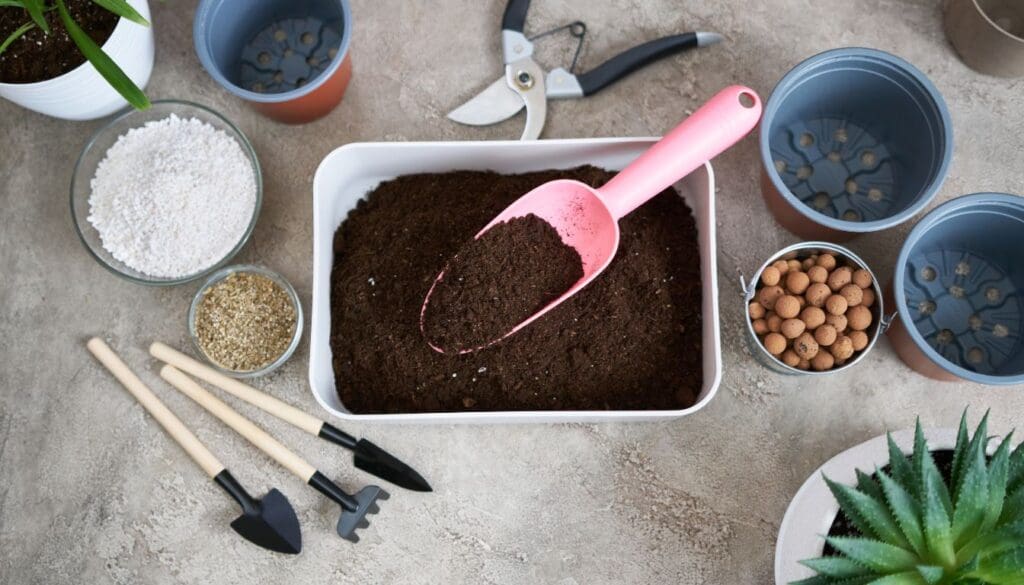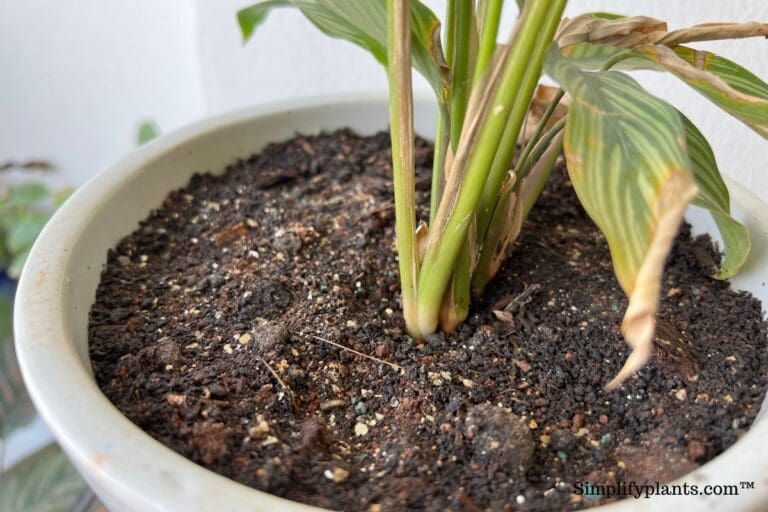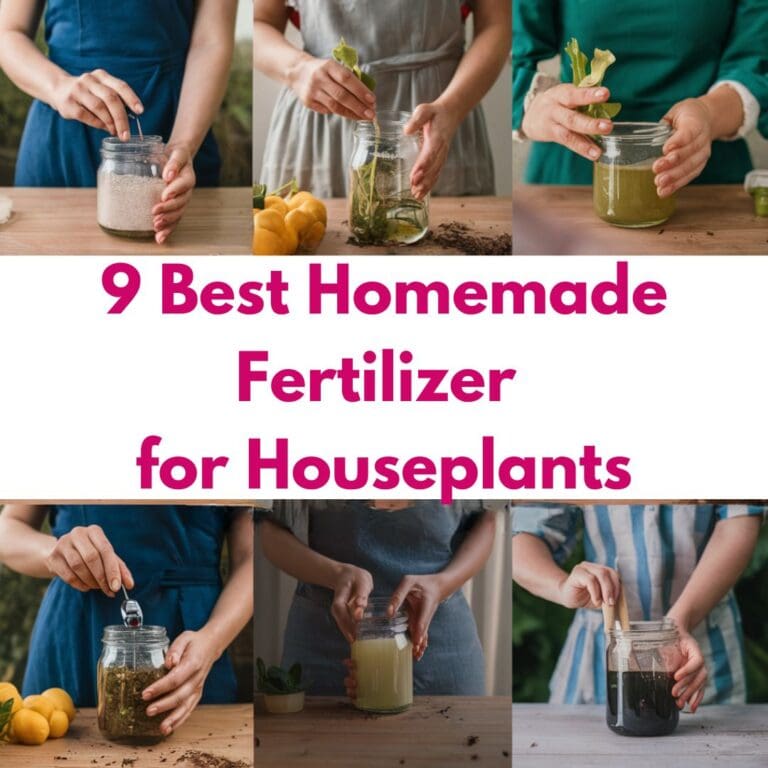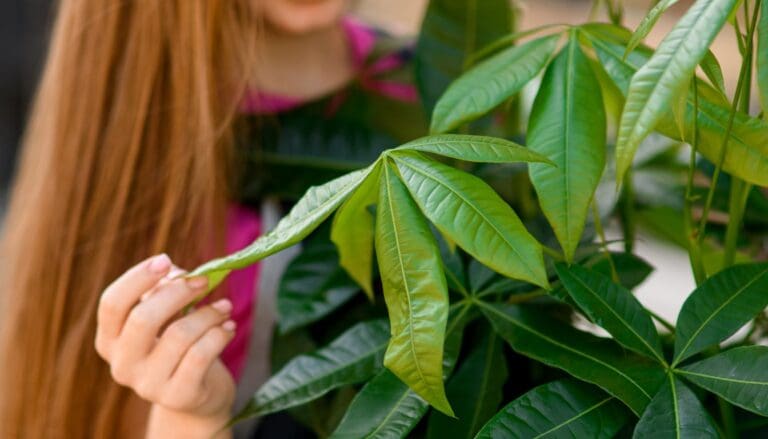Best Potting Mix Recipe That Works For Most Tropical Houseplants!
Creating the perfect potting mix for tropical houseplants is like becoming a gourmet chef for your green buddies – they’ll thrive with the right combination of ingredients!
Every plant parent knows the struggle of finding just the right soil that holds moisture but also drains well. It can feel like a balancing act, right?
I’ve found that a good potting mix can make all the difference. It’s not just dirt; it’s the cozy home for your plant’s roots, where they’ll find food, water, and everything they need to grow tall and strong.
Think of it as crafting the ultimate smoothie for your plant’s growth – they need just the right mix to flourish! 🌿✨
Have you ever mixed your own potting soil? It’s a game-changer! I’m talking about a blend that’s light, airy, and just perfect for those humidity-lovers in your home.
Imagine the satisfaction as you watch your tropical beauties burst into new growth because they’re absolutely loving the mix you’ve given them.
Share your experiences or thoughts down below; I’d love to hear what magic mixes you’ve whipped up for your leafy friends! 🌺🌱
Please note: Simplify Plants is reader-supported. As an Amazon Associate, I earn from qualifying purchases made by our readers with no extra cost added to you all! Some links in the post are affiliate links and I get a commission from purchases made through links in the post.
Understanding Potting Mixes
When it comes to tropical houseplants, I think we can all agree that they deserve the best home. But what does that mean in terms of their potting mix? Let’s dig right in!
Purpose of Potting Mix
Have you ever wondered why potting mix is so important? A top-notch potting mix does more than just keep your plants from tipping over – it’s practically a mini ecosystem!
It’s all about:
- Aeration: Roots need to breathe, too! 🌬️
- Drainage: Overwatering who? We don’t know her.
- Nutrients: The all-you-can-eat buffet for your leafy friends.
- Support: It’s like a comfy couch for plant roots.
Common Ingredients
When I’m mixing up a potting blend, these are my go-to ingredients:
- Organic Potting Mix: The foundation of any great potting soil. It’s like the bread in a PB&J sandwich – essential! 🍞
- Perlite: Think of perlite as the pumice stones of the soil world – it helps with water drainage.
- Peat Moss: Perfect for moisture and retaining those yummy nutrients.
- Vermiculite: If perlite is the drainage king, vermiculite is the moisture queen. 💧
And remember, you’re the chef in your plant kitchen so feel free to tweak the recipe to suit your green babies’ tastes!
What’s your secret ingredient? Drop a comment and let me know! 🌱✨
Basic Potting Mix Recipe
Creating the perfect potting mix for your tropical houseplants might just be the secret to getting that lush indoor jungle vibe. 🌴 It’s all about the balance of ingredients!
Ingredient Ratios

For the typical tropical plant, a well-draining and nutrient-rich potting mix is key. Here’s a simple recipe I swear by:
I’ve found that this combination provides the ideal mix of aeration, moisture retention, and nutrients. Plus, it’s super easy to remember: 60-30-10!
Mixing Instructions
Mixing your potting soil is like baking a cake—get your proportions right for delicious, I mean, thriving plants! 🌿
- Pre-moisten your peat moss or coir fiber; this makes the mixing process easier.
- In a large container, combine all ingredients thoroughly. You’re aiming for an even blend where each scoop gives your plants a little taste of everything.
- Before potting, make sure the mix is moist but not soaking wet. We want moist chocolate cake, not a soggy mess, right?
Have you tried mixing your own potting soil? What’s your go-to recipe? Drop your tips in the comments and let’s help our tropical buddies thrive together! 🌺🌱💬
Customizing Your Mix
Crafting the perfect potting mix for your tropical houseplants is a bit like being a chef – you’ve got to tweak the recipe to suit the diners, or in this case, the plants!
Let’s dive into specific mixes for different types of houseplants, each with their unique needs. Remember, happy roots equals a happy plant! 🌱
For Succulents and Cacti

Succulents and cacti love to lounge in dry conditions – kind of like a desert vacation. They need a mix that drains faster than a kitchen sink! I recommend combining:
- 3 parts potting soil
- 2 parts coarse sand
- 1 part perlite or pumice
This mix makes sure water zips through without leaving soggy soil behind. Want a pro tip? Add a pinch of bone meal for extra-strong roots.
For Orchids

Orchids are the divas of the plant world; they demand a spotlight and a special mix to strut their stuff. They live their best life in:
This blend provides plenty of air pockets for those diva roots. Did you know orchids like their homes as airy as a cloud? 😊
For Aroids

Aroids, including the stars like Monstera and Philodendron, crave a mix that’s just as lush and tropical as they are! Check this out for your aroid squad:
- 2 parts peat or coco coir
- 1 part perlite
- 1 part orchid bark
This creates a rich yet breathable environment. Imagine your aroids are having a spa day, every day – they’ll love you for it!
Have any of you tweaked these recipes to perfection? Drop your secret ingredients in the comments! 🌟 Let’s grow our knowledge together!
And hey, if you hit the jackpot with your mix, share the love and this article with your fellow green thumbs. 💌
Troubleshooting Common Issues
Have you ever felt like you’ve hit a bit of a green wall when it comes to keeping that lush foliage looking its best? Let’s sort out some of the trickier parts together!
Water Retention Problems
Is your tropical pal thirstier than a camel in the desert? Sometimes it’s quite the puzzle figuring out why your soil is more draining than expected. Here’s what I do:
- Check the mix: It may not hold enough moisture for the drama queens like Ferns and Calatheas. If the mix dries out faster than you can say “thirsty,” consider adding more peat moss to your potting mix.
- Feeling the soil: Your finger is your best tool. If the top inch is dry, it’s time to water. But if the soil stays soggy, you might be overdoing it, and root rot could be on the march!
Nutrient Deficiency Signs

Ever notice your plant’s leaves turning yellow when they should be channeling their inner green goddess? Those plants might be screaming out for a snack. 🍽️
Nutrient deficiencies can be a plant parent’s nightmare, but here’s how you can wake up from it:
- Yellowing leaves: Classic tale of nitrogen deficiency. I recommend sprinkling a balanced, organic fertilizer onto the soil or using a liquid feed to give them a quick boost.
- Poor growth or pale leaves: Might be a sign that your plant is lacking in potassium and phosphorous. Give them a bit more of these essential nutrients for some pep.
When your tropical houseplants are acting up, think of it like solving a mystery. 🕵️♂️
Keep these tips in your plant care toolkit, share your own tricks in the comments, and let’s help those tropical beauties thrive!
Storing Your Potting Mix
Before I dive into the nitty-gritty, remember, the way you store your potting mix can really make or break your plant’s happiness. Let’s get our hands dirty with some storage sorcery! 🪄✨
Best Practices for Storage
First things first, I always make sure the storage area is cool and dry. Moisture is the enemy here; it invites mold and pests to what should be your plant’s cozy bed.
So, no bathrooms or damp basements for our green friends’ future home! 🌿
Now, I use airtight containers to barricade my precious soil from the evils of dampness and creepy crawlies.
I’ve heard some plant buddies swear by storage bins or even resealable bags, as long as they are sealed tightly.
Remember, we’re like the superheroes of soil storage, battling the forces of moisture and air at every turn! 💪
Have you ever realized halfway through gardening that you have nowhere to put your leftover soil? 😅
I find labeling my containers super helpful, too. That way, I always know what’s what and don’t end up mixing cactus mix with fern mix—total party foul in the plant world, am I right?
Shelf Life
Now, let’s talk shelf life.
Potting mix doesn’t age like fine wine, folks, and its nutrients can say “sayonara” if stored improperly or for too long.
I like to keep mine not more than a year, to ensure my leafy pals get all the good stuff they deserve. 🌺
Dry is the word!
A potting mix that’s dry and free from organic growth like mold can last that long on the shelf.
But if it feels funky or smells off, better off bidding it goodbye than risking my plants’ health. Who else has been there, right?
Environmental Considerations
When I mix up potting soil for my leafy friends, I like to think green in more ways than one! 🍃 Let’s make our plant hobby a win for the Earth too!
Sustainable Materials
Did you know that choosing the right ingredients for your potting mix can help the planet as much as your plants?
Let’s talk peat moss—super common, but it comes from peat bogs which are like nature’s ancient archives and take centuries to form.
My go-to is coco coir, a renewable byproduct from coconut processing. It’s pH neutral, just like peat, and your tropicals will love it! 🌴
Plus, recycling coconut husks for my Monstera? Talk about tropical recycling!
Reducing Waste
Potting mixes don’t have to be one-and-done.
I like to reuse older potting mix by refreshing it with some new compost or coir.
When it’s time to retire that mix from pot duty, it gets a second life in my outdoor garden beds. 🌻
Got empty plastic soil bags? I turn them into planters or use them for toting garden tools.
What about you—any clever tips for giving old potting mix or packaging a new purpose? Drop a comment below and let’s get those ideas blooming! 🌱
Advanced Tips and Tricks

If you’re anything like me, you love getting into the nitty-gritty of plant care.
So let’s dive into a couple of advanced topics to really give your tropical houseplants a boost!
pH Level Adjustments
It’s all about the pH, folks!
Most houseplants thrive at a pH between 6 and 7.
If your mix is too acidic—hello, yellow leaves!—you can sprinkle a bit of lime to nudge it higher.
Too alkaline? A dash of sulfur might do the trick. 🍋
Here’s a pro tip: grab yourself a pH test kit from your local garden store to keep tabs on your soil’s status.
Incorporating Slow-Release Fertilizers
Okay, let’s talk food—plant food, that is!
Slow-release fertilizers are like a gourmet meal for your greens, providing nutrients over time.
Begin by mixing about 20-30% of the slow-release granules into your potting mix.
This will help your plants grow strong without overloading them all at once.
Remember, more is not always better—a little goes a long way! 🐢
Got any soil secrets of your own? Drop them in the comments and share the plant love! 🌿💚 Don’t forget to share this with your plant pals!
FAQs
What’s the best base for a tropical houseplant potting mix?
Well, I’ve found that a good peat-based or coco coir mixture does wonders. It’s light and airy, perfect for root growth! 🌱
Any tips on how to keep my potting mix fresh?
Sure thing! Try not to let it dry out completely, and fluff it up periodically for that ‘just-mixed’ feel!
Do I need to adjust the pH of my potting mix?
Absolutely, most tropical plants crave a slightly acidic to neutral pH. When using peat, a pinch of garden lime can do the trick to balance it out. 🍋➕👌
What about my water-loving plants like Ferns and Calatheas?
Add some peat moss to increase water retention, keeping those thirsty friends happy! 💦
Can I use regular garden soil?
Hold up! Garden soil can be too dense for pots. Stick with a specially made potting mix to avoid any root regrets.
When should I refresh my potting mix?
I’d say, give it a rejuvenation when you notice your plants are less “perky” or about once a year. It’s like their very own spa day! 🛀🌿
What if I have cacti or succulents?
They prefer a different setup. Mix in more perlite or sand for that desert-like home they love!
Conclusion
I’ve had my share of potting mix adventures, and trust me, finding the right blend for your tropical houseplants can be like discovering your favorite coffee blend – totally worth the experimenting! 🌿👩🔬
Here’s a quick wrap-up of what we’ve learned:
- Use a base of sphagnum peat moss or coco coir for moisture retention.
- Add perlite or pumice to ensure good aeration and drainage.
- Throw in some compost or worm castings for that nutrient kick.
- Remember, a pinch of lime will neutralize excess acidity when using peat moss.
Don’t forget the customization part!
Got a thirstier plant, like a Fern or a Calathea? Feel free to mix in a bit more peat.
If you’re dabbling in the world of cacti, scale back on moisture-retaining ingredients and pump up that perlite.
Hey, have you tried these tips? Or maybe you’ve got a secret ingredient up your sleeve? 🤫
Share your potting mix successes (or fails) in the comments. We’re all in this green journey together, and I can’t wait to read about your experiences! 🌱💬
Remember, the best potting mix is one that makes your plants happy and your heart sing every time you see new growth.
So, happy mixing — and let’s turn our homes into tropical paradises! 🏡🌴✨
Don’t be shy, give that share button some love if you found this guide helpful!
Recommended Garden Supplies
| Product Image | Our Recommended Gardening Supplies | Check Offers! |
|---|---|---|
Top Top
Top
Top
Top
Top
Top
Top
Top | rePotme Houseplant and Tropical Classic Potting Soil Mix | Check Offer On Amazon |
 Top
Top
Top
Top
Top
Top
Top
Top | Espoma Organic Indoor Plant Food | Check Offer On Amazon |
 Top
Top
Top
Top
Top
Top
Top
Top | GooingTop LED Grow Light 6000K Full Spectrum Clip Plant Growing Lamp | Check Offer On Amazon |
 Top
Top
Top
Top
Top
Top
Top
Top | Soil Moisture Meter | Check Offer On Amazon |
 Top
Top
Top
Top
Top
Top
Top
Top | Govee Hygrometer Thermometer, Bluetooth Enabled! | Check Offer On Amazon |
 Top
Top | LEVOIT Humidifiers for Large Room(Best For Plants) | Check Offer On Amazon |
 Top
Top
Top
Top
Top
Top
Top
Top | Upgraded DIY Automatic Drip Irrigation Kit, 15 Potted Houseplants Support | Check Offer On Amazon |
 Top
Top
Top
Top
Top
Top
Top
Top | Stainless Steel Heavy Duty Gardening Tool Set | Check Offer On Amazon |
 Top
Top
Top
Top
Top
Top
Top
Top | Bonide Insecticidal Soap | Check Offer On Amazon |
 Top
Top
Top
Top
Top
Top
Top
Top | Bonide 32 oz Spray Neem Oil for Organic Gardening | Check Offer On Amazon |
 Top
Top
Top
Top
Top
Top
Top
Top | Garden Safe Fungicide | Check Offer On Amazon |







